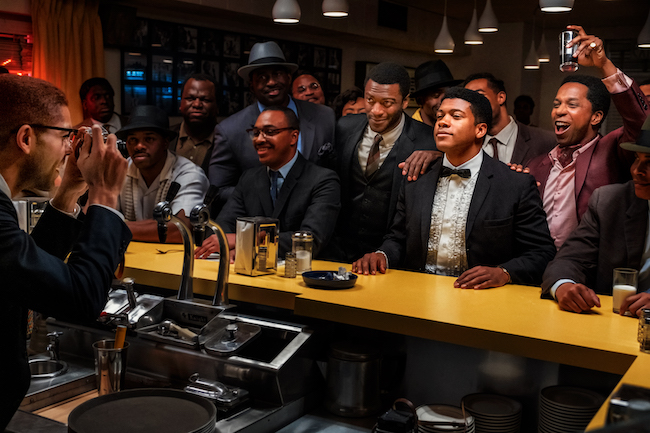
Source: Amazon Studios / Courtesy of Amazon Studios
By Darralynn Hutson
Because Black non-profits often find themselves between a rock and a hard place when it comes to survival, they are often forced to deal with being made to feel invisible. And for those injected into the Hollywood machine, while glorified momentarily, the feeling of invisibility can hit twice as hard when the moment of being in the spotlight passes. A motel that is the setting for the story in the new film One Night Miami, albeit not physically, can attest to that struggle, and hopes the moment won’t pass for their treasured space.
There’s plenty of buzz surrounding the project, debuting on Friday (January 15) on Amazon Video, which features Kemp Powers’ story and Regina King’s directorial work. It tells of a monumental event, the gathering in a Miami motel of Muhammad Ali, then known as Cassius Clay, Malcolm X, Sam Cooke, and Jim Brown as they face the responsibilities that come with being successful Black men in the public eye during the civil rights movement. As those behind the film were preparing to release the project, around the same time in another part of America, in the motel portrayed in the film, the Hampton House, a small group of mostly 70 and 80-year-old women met to discuss ideas in a desperate attempt to keep the space relevant. After years of convincing Miami’s Dade County to keep their word of preserving the property, the historic Hampton House, although partially restored, still struggles to stay afloat.
“It took the county so long to come up with the money for the restoration even though we’d gone through the process of getting into the General Obligation Bond Program and the voters approved it,” says Dr. Enid Pinkney, 89, founder of the Historic Hampton House Foundation. “The General Obligation Bond started in 2004, yet the county didn’t start the construction until 2015. A lot of Black people felt that they weren’t going to give us the money and that we’d never get the money like they were playing games with us. It was just discouraging after so many years. I had to dispel that and get out in the community and get Black people to vote. It would be a battle. It’s been a long battle to bring the Hampton House back. County members have come and gone.”
During a recent tour of the property, the new manager, Imani Warren, voiced her frustration over how the Hampton House board of directors had been treated. “Dade county thought Dr. Pinkney would pass away so they would not be held accountable. She let them know that she was not going to die until this building was completely renovated and servicing this community,” she says. “Her birthday last year was our biggest fundraiser for the Hampton House. This place has been held together because of her resilience and fight.”
The struggling non-profit is essentially the fifth character in an Oscar-targeted film and no one knows or cares that it is going under.
“What I would like to see is some of the things that I promised when I told Black people to vote for the program; when I was going around trying to pursue Black people to vote for it. I wanted it to really become a cultural arts center,” says Dr. Pinkney. “I want us to have enough money to have someone in there teaching about the history of the Hampton House. I want to eventually see kids and people working with them on how to become writers and poets, and how to dance, learn about music, and all of the amenities. We can’t do it now because we don’t have the money.”
The Historic Hampton House and Cultural Center, as it is now called, is actually quite large in structure. You could get lost if you were a child running the halls, as was likely an occurrence back in its heyday when Black families roamed the floors. It’s structure, though needing work, is still a sight to see. There’s an expansive lobby, having been restored, and it has a grand piano and spiral staircase. Guest rooms with the purpose of educating that used to house sleeping guests are still being gutted out and stay closed to patrons. The pool no longer invites chocolate beauties in bikinis but instead a colorful waterfall. It has an open renovated event space with a balcony overlooking it. There are three rooms that remain intact and completely restored, which were portrayed in the film: one for Malcolm X, another for Cassius Clay, and the infamous bar-stooled restaurant where many celebrations were held. Opened in 1954 under the name of the Booker Terrace Motel, then renamed in 1961, the Hampton House offered a safe space for the Black elite to relax and let their hair down in a segregated Miami. The completion of the property still awaits promised funding from the county so it can be a safe space, yet again, for the community in the present day.
Wayne Hudson, whose public relations firm represents the Hampton House, sees a great benefit to the motel’s replicated image holding a major role in One Night in Miami. He says that the board is hopeful about what will come about from the attention.
While it’s nice to know Hampton House exists, its existence was important enough to play a part in inspiring a theater production and now a movie. Therefore, it is also just as important now to make sure that it survives.
Find out more about how you can support the Historic Hampton House:









